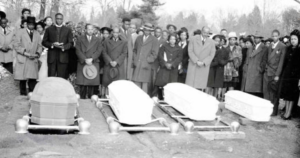Originally written by Carl White.
As I was scanning some of the Gotch historical photograph collection, I came across several photos of four caskets. The outside of one envelope read “Wiggins 1948.” One photo shows four caskets in the Bethel AME Church on Lake Avenue (across from the hospital), and another photo shows the burial site. Curiosity got the best of me, so I decided to check the Greenwich Time microfilm to see if I could find out any information. Greenwich Time indicated that the fire occurred on March 23, 1948.

Wiggins Family Members
The Wiggins family lived in a single-story house (bungalow) at 37 Melrose Avenue. The front was covered in fake red brick asbestos. There were two bedrooms, a living room, and a kitchen. The floor space measured 25 square feet, and it was assessed for $1630. Seven family members shared the home: Mr. Samuel R. Wiggins (47), Mrs. Samuel Wiggins (38), Richard Randolph Wiggins (13), Samuel J.H. Wiggins (12), Myrna Valerie Wiggins (11), Barbara Diane Wiggins (10) and Clara Louise Wiggins (4). Mrs. Wiggins was born in Garnett SC, and lived in Greenwich for 12 years.
Normal Day For Wiggins Family
Mr. Wiggins worked for Jenkins Valve Company in Bridgeport. He usually got up at 4:30 am each day and got dressed. Then he would go through the kitchen to the front living room, where he ignited 1 burner of a 2-burner kerosene oil stove. He would use this to heat a pot of coffee to fill his thermos. His three young daughters slept in the northwest corner of the house. As he did every day, he went in to check on them. Once he saw they were safely sleeping, he went to the kitchen and detached a kerosene tank from the kitchen stove. Wiggins took this out back to a storage tank in the backyard to refill.
Fire Discovered
This only took about 10 minutes. When he returned and entered the back door, he immediately smelled smoke. He ran to the front of the house and saw that the 2-burner stove was ablaze. At this point, he dropped the kerosene tank. Wiggins and his two sons somehow managed to drag the flaming stove from the house; but the stove’s kerosene tank fell off, spraying flammable kerosene across the floor, further feeding the fire. Although he attempted to return to the living room, he couldn’t re-enter the house due to the smoke and fire.
Meanwhile, Mrs. Wiggins had awoken and tried to warn the three girls. She also tried to call the Fire Department but succumbed to the smoke and passed out. Fortunately, the operator was able to identify the caller and address. She completed the call to the Fire House and the firemen responded at 5:11 am. When the pumper pulled up to the house, it was fully engulfed in flames. They tried to enter the house, but couldn’t get closer than 15 feet. Policeman F. Lawrence Bria ran to the back door, and attempted to crawl into the house on his hands and knees, but was forced back by the smoke and fire. Fireman James Platley smashed the front bedroom window, climbed into the room, and handed a body of a young girl out the window.
Efforts To Revive
The remaining bodies were carried outside. The firemen and policemen tried to revive the bodies for an hour and a half. They tried resuscitators, inhalators, and artificial respiration – all to no avail. In the end, Mrs. Wiggins and her three daughters perished. Although one of their kittens succumbed, three others were found trembling in a corner of the house. Their pet dog was found running around hysterically, and he refused to leave the bodies for some time. Mr. Wiggins and his two sons managed to survive. This had been the worst fire tragedy to hit Greenwich up to this point.
Aftermath of the Fire
The community offered assistance to the grieving survivors. The American Red Cross purchased new Easter clothing for the family since all their possessions had been lost in the fire. Neighbors offered food and shelter, while the Department of Public Welfare provided counseling. The Bethel AME Church also offered comfort and support.
The ironic part of the disaster was that the front window of the house was only a few feet above the ground. If the mother and children could have jumped out, they would have survived. Another house in the neighborhood had burned down approximately five years prior to the Wiggins Family fire. Since that time, the building and fire codes have undergone many changes, designed to protect the safety of our citizens. Hopefully, there will never be a repeat of this horrendous disaster.
SOURCE
Webster, K: Mother, 3 small children perish in early morning blaze; Father and 2 sons escape; Greenwich Time; Greenwich Publishing Co.; Mar 23, 1948.
ABOUT
Build your family tree, dive into the history of your historic home, and discover photos and articles of days gone past with the Library’s collection of 5,000 books, 800 Oral History transcripts, yearbooks, historical maps, vertical files, pamphlets, periodicals, and microfilm and microfiche. Plus, access resources like American Ancestors, AncestryLibrary, and more with a Library card. Learn more at greenwichlibrary.org/genealogy.
Get the latest about the Library’s History & Genealogy events and offerings sent to your email: greenwichlibrary.org/enews.
Questions? Contact:
Local History Librarian
(203) 622-7948
